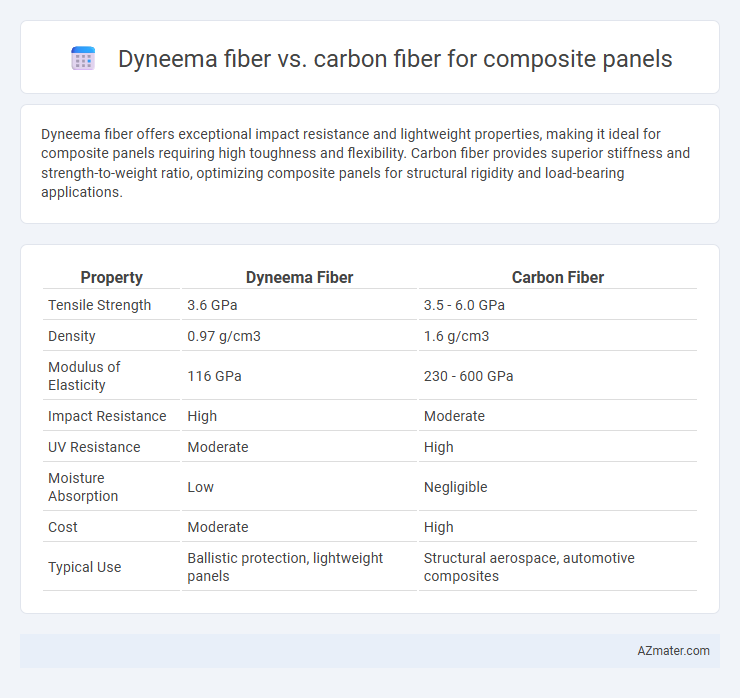Dyneema fiber offers exceptional impact resistance and lightweight properties, making it ideal for composite panels requiring high toughness and flexibility. Carbon fiber provides superior stiffness and strength-to-weight ratio, optimizing composite panels for structural rigidity and load-bearing applications.
Table of Comparison
| Property | Dyneema Fiber | Carbon Fiber |
|---|---|---|
| Tensile Strength | 3.6 GPa | 3.5 - 6.0 GPa |
| Density | 0.97 g/cm3 | 1.6 g/cm3 |
| Modulus of Elasticity | 116 GPa | 230 - 600 GPa |
| Impact Resistance | High | Moderate |
| UV Resistance | Moderate | High |
| Moisture Absorption | Low | Negligible |
| Cost | Moderate | High |
| Typical Use | Ballistic protection, lightweight panels | Structural aerospace, automotive composites |
Introduction to Dyneema Fiber and Carbon Fiber
Dyneema fiber, known as ultra-high-molecular-weight polyethylene (UHMWPE), offers exceptional tensile strength and impact resistance, making it a lightweight and durable choice for composite panels. Carbon fiber is composed of tightly woven carbon atoms, delivering superior stiffness, high strength-to-weight ratio, and excellent thermal stability critical for advanced composite applications. Both fibers serve distinct roles in composite panel manufacturing, with Dyneema favored for flexibility and impact absorption while carbon fiber excels in rigidity and structural support.
Material Composition and Properties
Dyneema fiber, a high-performance ultra-high-molecular-weight polyethylene (UHMWPE), offers exceptional tensile strength and impact resistance while maintaining lightweight properties, making it ideal for composite panels requiring high toughness and flexibility. Carbon fiber, composed of thin strands of carbon atoms bonded in a crystalline structure, provides superior stiffness, high tensile strength, and excellent thermal stability, which excels in applications demanding rigid and lightweight structural components. Both materials enhance composite panels but differ significantly in mechanical behavior, with Dyneema favoring impact absorption and carbon fiber prioritizing structural rigidity and heat resistance.
Strength-to-Weight Ratio Comparison
Dyneema fiber offers an exceptional strength-to-weight ratio, exceeding that of many carbon fibers by providing ultra-high tensile strength while maintaining significantly lower density. Composite panels reinforced with Dyneema achieve superior impact resistance and flexibility without compromising lightweight properties, making them ideal for aerospace and ballistic applications. Carbon fiber composites deliver high stiffness and tensile strength but generally have higher density, resulting in a comparatively lower strength-to-weight ratio than Dyneema-based composites.
Impact Resistance and Toughness
Dyneema fiber exhibits superior impact resistance and toughness compared to carbon fiber in composite panels, due to its ultra-high molecular weight polyethylene (UHMWPE) structure, which provides exceptional energy absorption and durability under high strain. Carbon fiber composites, while offering higher stiffness and strength-to-weight ratios, tend to be more brittle and prone to cracking or delamination upon impact. For applications demanding enhanced toughness and resistance to sudden impacts, Dyneema-reinforced composites are often preferred over carbon fiber alternatives.
Flexibility and Fatigue Performance
Dyneema fiber exhibits superior flexibility compared to carbon fiber, allowing composite panels to withstand repeated bending without cracking. Its exceptional fatigue performance enables Dyneema-reinforced composites to maintain structural integrity over extensive cyclic loading, outperforming the more brittle carbon fiber panels. This combination makes Dyneema ideal for applications requiring high durability and resilience under dynamic stress.
Applications in Composite Panels
Dyneema fiber offers exceptional impact resistance and lightweight properties, making it ideal for ballistic and protective composite panels used in military and aerospace applications. Carbon fiber provides superior stiffness and high tensile strength, making it the preferred choice for structural composite panels in automotive and aerospace industries where rigidity and weight reduction are critical. Both fibers deliver unique performance advantages, with Dyneema excelling in energy absorption and carbon fiber in load-bearing applications within composite panel manufacturing.
Manufacturing and Processing Techniques
Dyneema fiber offers superior flexibility and impact resistance in composite panels, enabling manufacturing techniques such as resin infusion and filament winding with lower fiber breakage risk compared to carbon fiber. Carbon fiber requires high-temperature curing processes like autoclave or compression molding, suited for rigid, high-strength panels but demanding precise thermal and pressure controls. The processing of Dyneema composites often involves room-temperature or low-temperature curing cycles, reducing energy consumption and enabling faster production times relative to carbon fiber composites.
Cost and Availability Analysis
Dyneema fiber offers a relatively moderate cost with high availability due to its widespread use in ballistic and rope manufacturing, making it an accessible option for composite panels. Carbon fiber, while significantly more expensive, benefits from extensive industrial demand and supply chains, but its production costs and market price remain higher compared to Dyneema. Cost-effectiveness of Dyneema fibers in composite panels is driven by abundant raw materials and scalable manufacturing, whereas carbon fiber's limited availability and complex processing increase its overall expense.
Environmental Considerations and Sustainability
Dyneema fiber offers superior environmental benefits compared to carbon fiber due to its lower energy consumption during production and higher recyclability, reducing overall carbon footprint in composite panels. Carbon fiber manufacturing involves high-temperature processes and significant greenhouse gas emissions, whereas Dyneema's gel-spun ultra-high-molecular-weight polyethylene (UHMWPE) production is less energy-intensive. Sustainable composite panels incorporating Dyneema fibers contribute to longer product life cycles and enhanced end-of-life recyclability, promoting circular economy principles in advanced material applications.
Conclusion: Choosing the Right Fiber for Composite Panels
Dyneema fiber offers exceptional impact resistance and lightweight properties, making it ideal for applications requiring high durability and flexibility in composite panels. Carbon fiber provides superior stiffness, tensile strength, and thermal stability, suited for structural components demanding rigidity and high load-bearing capacity. Selecting the right fiber depends on the specific performance requirements of the composite panel, balancing the need for toughness with stiffness and weight considerations.

Infographic: Dyneema fiber vs Carbon fiber for Composite panel
 azmater.com
azmater.com